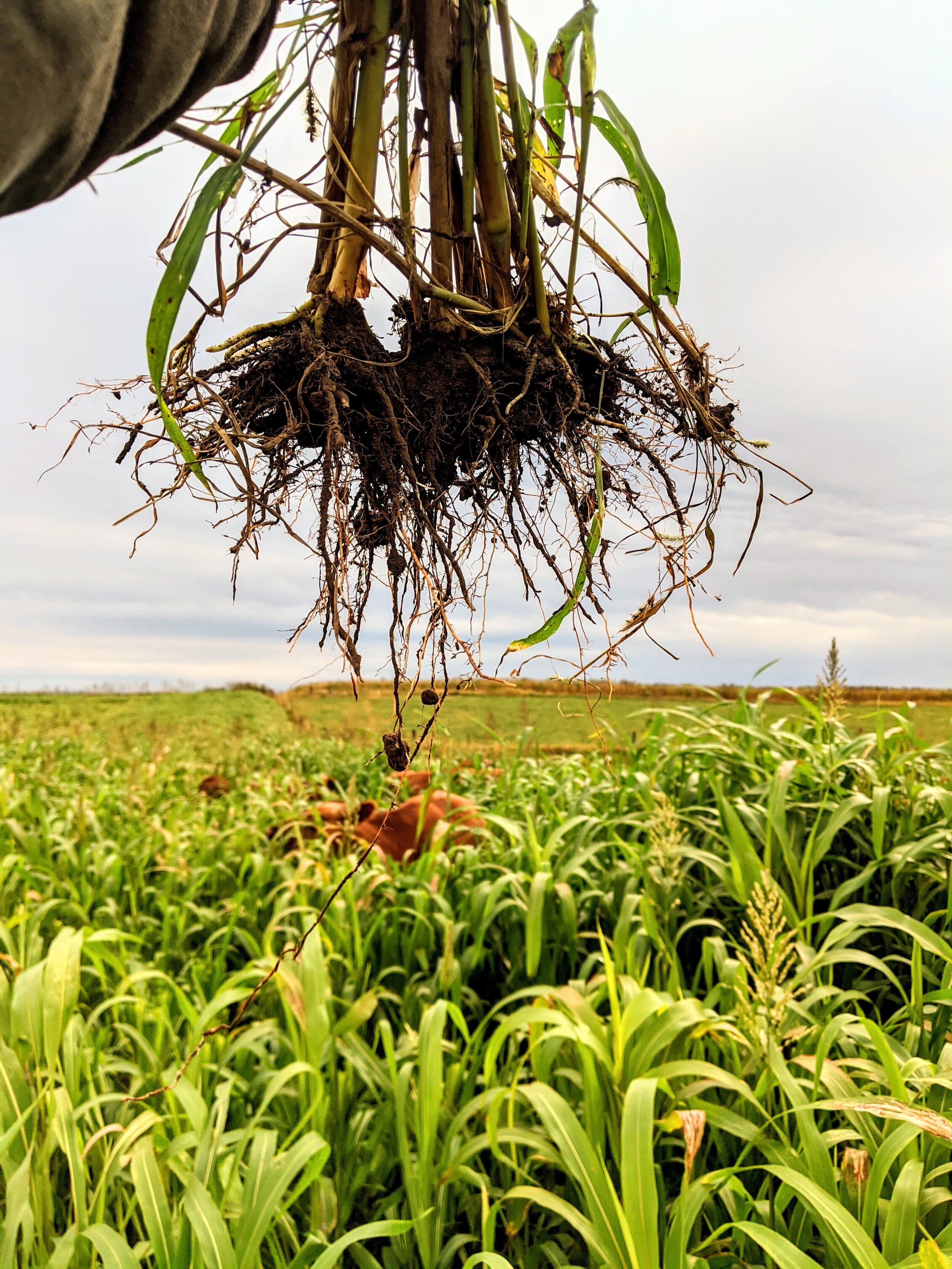Soil Health Principles
On our farm, our goal is to not only farm sustainably but to use regenerative agriculture practices to heal the land. The choices we make on our farm are important to the health of our land, livestock and family. They are also important to you as a consumer of the grassfed beef, pork and chicken raised on our farm. We choose to follow the soil health principles.
1) Soil armor
2) Minimize soil disturbance
3) Plant diversity
4) Living roots
5) Livestock integration
Soil armor
Our goal is to cover 100% of the soil on our land with a green, growing plant during the growing season and leave residue during the dormant periods. We evaluate soil armor by looking straight down at the soil surface and asking, “What percent of the soil is protected by the residue?”
Soil is where the health of the food produced on our farm starts. The soil holds the valuable nutrients plants utilize and our livestock need to grow and one day become nutrient dense meat for your family and ours. We must protect the soil from erosion, compaction, high temperatures and weed pressure. Growing plants on our soil also offers a home for hundreds of species of insects and wildlife.
Here’s a photo comparing before and after grazing cattle for one day or less. The top, left side has not been grazed and the bottom, right side they grazed for one day. While it may look like there’s lots of grass left after grazing, that’s our goal! To leave a cover to protect the soil.
Minimize Soil Disturbance
We want to minimize disturbances to the natural processes that occur in soil. We limit disturbances to our soil by choosing not to apply chemicals of any kind, limiting tillage and rotationally grazing. Each of these choices helps our soil rebuild and support healthy pastures and healthy livestock long term.
Minimizing disturbance is also important for wildlife, such as the monarch butterflies. Hundreds of them called our farm home this fall for a few days as they migrated south. We see wildlife almost every day.
Plant Diversity
While it may look different today, Lewis and Clark describe an abundant amount of diversity in types of plants across the great plains. This is beneficial because each plant species offers something unique to the soil ecosystem. Our goal is to increase diversity in our pastures ideally with a mixture of grasses, legumes, and forbs.
Late summer is typically a difficult time to continue grazing because the grass begins growing slower than early summer. We choose to plant a diverse mixture of species as a cover crop for our livestock to graze.
Living Roots
Living roots are powerful!
When making choices on our farm, we prioritize taking care of our land, environment and livestock. One of the ways we care for our land and soil - and in turn our livestock - is by keeping living roots in the soil as much as possible.
Roots hold the soil in place, even if we get a lot of rain.
Roots send nutrients into the soil.
Roots improve water quality and infiltration.
Roots break up soil compaction.
We planted a mix of sorghum, sunflowers and a few other species to keep a living root in our pastures and care for our soil. But those living roots are also providing our cattle with high quality, nutrient dense plants to eat, which in turn, produces an excellent, nutrient rich source of protein for us to enjoy.
When soil is healthy, so is our food.
I used a shovel and dug a few plants out of this pasture the cows are currently grazing. Look at those roots!
Living roots are important in every season. Even while it snows, we leave a living plant in the ground. It is amazing how long the pasture stays green.
Livestock Integration
The first 4 soil health principles by themselves are beneficial to our soil, but livestock is what ties them all together. Diverse plants left idle and ungrazed will mature and die early in the growing season. When these plants die, their leaves can no longer photosynthesize which is the extremely important process of taking carbon from the atmosphere and pumping it into our soils through the roots. They also shade out new plant growth. Livestock act as pruners, setting back the grass through grazing and allowing them to grow new leaves. These leaves will continue the photosynthesis process and the sunlight exposure will encourage new plant growth beneath them. These living plants are what continue to pump carbon into our soils feeding soil biology which in turn make nutrients available to our plants which are eaten by the livestock and produce healthy tasty nutrient dense meat for you!
Properly functioning soil ecosystems produce nutrient dense food for our livestock, creating nutrient dense meat for our family and yours.







